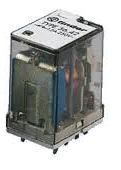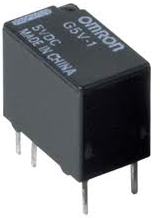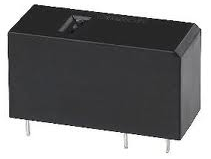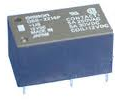Types of Relays

Relays are electrically actuated devices that act as switches. When the relay's coil receives sufficient voltage, its relay contact switch closes, turning the device connected to it on. When the voltage is shut off, the relay's switch opens, turning the device connected to it off.
There are many types of relays and, in this article, we go through many of the various kinds.
Types of Relays by Composition
There are 3 main types of relays: mechanical relays, reed relays, and solid state relays.
Mechanical Relays

Mechanical relays are usually the largest and most rugged of all relays. For a typical mechanical relay, a current sent through a coil magnet acts to pull a flexible, spring-loaded conductive plate from one switch contact to another.
In general, mechanical relays are designed for high currents (typically 2A to 15A), but they have relatively slow
switching (typically 10ms to 100ms).
Reed Relays

Reed relays are smaller than most mechanical relays and are somewhere in the middle between mechanical and solid-state relays. They are kind of the median.
They are designed for moderate currents (typically 500mA to 1A) and moderately fast switching (0.2ms to 2ms).
Solid-state Relays

Solid-state relays are transistors. They are usually the smallest in size of all relays, though they can at times be comparable to reed relays in size.
They come with a wide range of current ratings, from a few microamperes for low-powered packages up to 100A for high-power packages, and they
have extremely fast switching speeds (typically 1 to 100ns), the fastest of all relays.
Mechanical relays have the advantage that they can handle large amounts of current. They are used in applications where large
currents are used and switching speed is not critical. An application where mechanical relays are used is in car door locks. Solenoids
are used in which a current switches activates the solenoid, closing the switch. For an application like this, switching speed doesn't need to
be fast at all. Reed relays are used for moderate current and switching times. And solid-state relays are used in applications where high-speed
switching is necessary such as transistors in computers. Computers perform millions of instructions per second and need extremely quick
switching from transistors. In these applications, only solid-state relays will suffice.
Types of Relays By Poles and Throws
Single Pole Single Throw Relay

A Single Pole Single Throw Relay is a relay that has one input and one output terminal.
Internally, it is wired so it is connected as shown below:

Being that it only has one input and one output, they act as simple on-off switches in circuits, as they can only take on 1 of 2 states. When the relay does not receive any power, it is off and the Normally Open (NO) contact pin remains opens. When the relay receives sufficient power, the NO contact pin closes and whatever load is connected to it will power on.
For an in-detail description of SPDT relays, check out Single Pole Single Throw Relay
Wiring Diagram
Single Pole Double Throw Relay

A Single Pole Double Throw Relay is a relay that has one input and two outputs.
Internally, it is wired so it is connected as shown below:

Being that it has 2 outputs, it is more dynamic than a single throw relay. It can connect to 2 different outputs, so it can switch a circuit in between any 1 or 2 states, such as ready mode-pause mode, etc.
For an in-detail description of SPDT relays, check out Single Pole Double Throw Relay Wiring Diagram
Double Pole Single Throw Relay

A Double Pole Single Throw (DPST) Relay is a relay that has 2 inputs and 2 outputs.
Internally, it is wired so it is connected as shown below:

Each of the inputs can connect to one ouput. A DPST relay is constructed internally as if they are 2 separate SPST relays connected together. So a DPST is really just 2 separate SPST relays.
Double Pole Double Throw Relay

A Double Pole Double Throw (DPDT) is a relay that has 2 inputs and 4 outputs.
Internally, it is wired so it is connected as shown below:

The 2 input stages can each connect to 2 different outputs, allowing for 4 different output modes. A circuit with a DPDT allows for the most dynamic and versatile of outputs being that it can switch between these different modes.
For an in-detail description of DPDT relays, check out Double Pole Double Throw Relay
Wiring Diagram
Related Resources
How to Connect a Relay to a Circuit
Relay Terminals
Relay Wiring Diagrams
